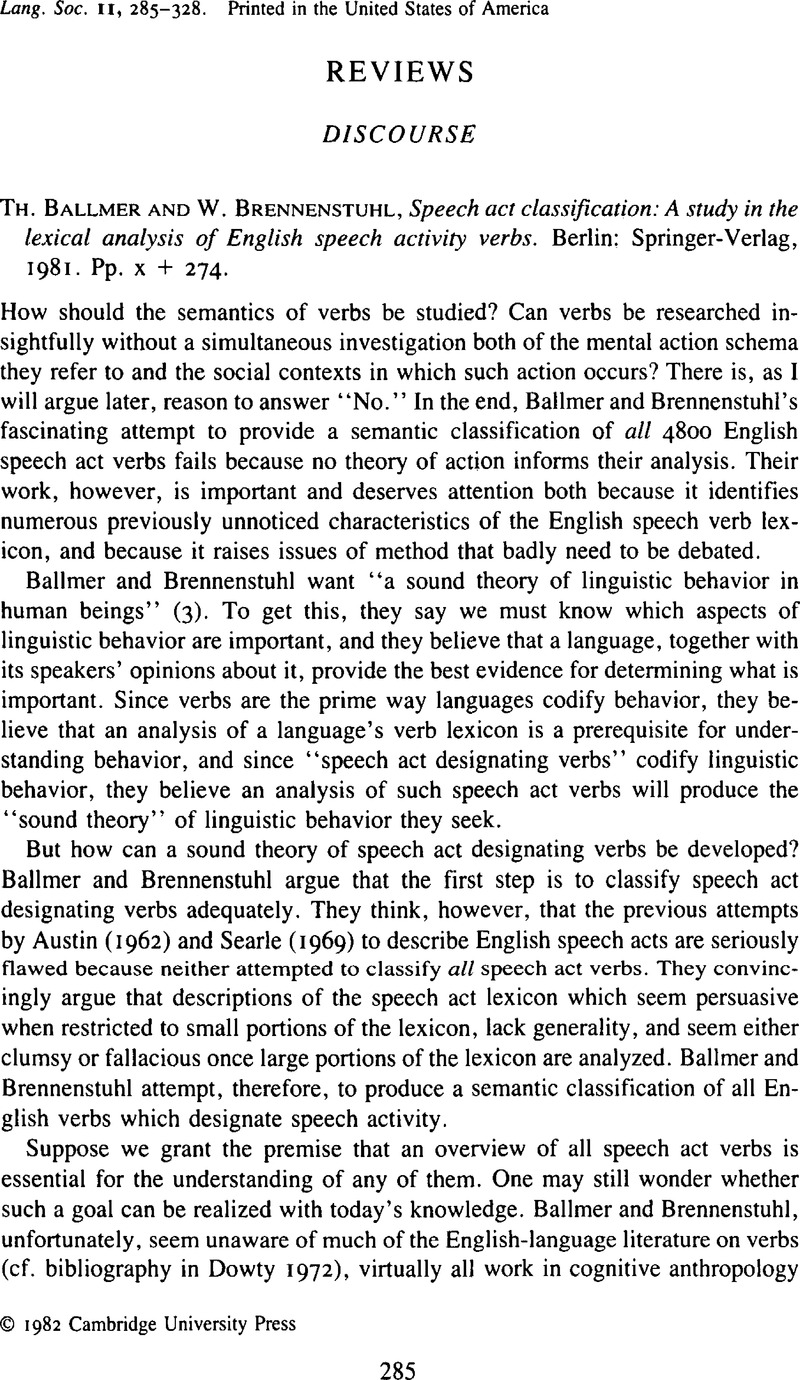No CrossRef data available.
Article contents
TH. Ballmer and W. Brennenstuhl, Speech act classfication: A study in the lexical analysis of English speech activity verbs. Berlin: Springer-Verlag, 1981. Pp. x + 274.
Published online by Cambridge University Press: 18 December 2008
Abstract
An abstract is not available for this content so a preview has been provided. Please use the Get access link above for information on how to access this content.

- Type
- Book Review
- Information
- Copyright
- Copyright © Cambridge University Press 1982
References
REFERENCES
Ballmer, T., Brennenstuhl, W., Ehlich, K., & Rehbein, J. (forthcoming). Sprachliches Handein (Listen, Kategorien, Modelle). Munich: Fink.Google Scholar
Berlin, B. (1972). Speculation on the growth of ethnobotanical nomenclature. Language in Society I: 51–86.CrossRefGoogle Scholar
Burling, R. (1969). Cognition and componential analysis: God's truth or hocus pocus? In Tyler, S. (ed), Cognitive anthropology. New York: Holt. 419–27.Google Scholar
Coleman, L., & Kay, P. (1981). Prototype semantics: The English word lie. Language 57:26–44.CrossRefGoogle Scholar
Dowty, D. R. (1972). On the syntax and semantics of the atomic predicate CAUSE. Papers of the Chicago Linguistic Society 8:62–74.Google Scholar
Frake, C. (1972). “Struck by speech”: The Yakan concept of litigation. In Gumperz, J. & Hymes, D. (eds.), Directions in sociolinguistics: The ethnography of communication. New York: Holt, Rinehart and Winston. 106–29.Google Scholar
Kay, P., & McDaniel, C. (1978). The linguistic significance of the meanings of basic color terms. Language 54:610–46.CrossRefGoogle Scholar
Newell, A., & Simon, H. (1972). Human problem solving. Englewood Cliffs, N.J.: Prentice-Hall.Google Scholar
Randall, R. (1977). Change and variation in Samal fishing: Making plans to ‘make a living’ in the Southern Philippines. Ann Arbor: University Microfilms 77–31511.Google Scholar
Randall, R. (forthcoming). Steps toward an ethnosemantics of verbs: Complex fishing technique scripts and the problem of listener identification. In Dougherty, J. (ed), New directions in cognitive anthropology.Google Scholar
Rosch, E., & Mervis, C. (1975). Family resemblances: Studies in the internal structure of categories. Cognitive Psychology 7:573–605.CrossRefGoogle Scholar
Schank, R. C., & Abelson, R. T. (1977) Scripts, plans, goals, and understanding: An inquiry into human knowledge structure. Hilisdale, N.J.: Lawrence Erlbaum Assoc. 101–30.Google Scholar
Searle, J. R. (1969). Speech acts: An essay in the philosophy of language. Cambridge University Press.CrossRefGoogle Scholar
Wright, G. von. (1967). The logic of action – a sketch. In Rescher, N. (ed), The logic of decision and action. Pittsburgh: University of Pittsburgh Press. 121–46.Google Scholar




